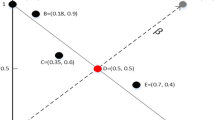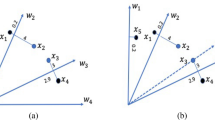Abstract
The large number of objectives in many-objective optimization problems (MaOPs) has posed significant challenges to the performance of multi-objective evolutionary algorithms (MOEAs) in terms of convergence and diversity. To design a more balanced MOEA, a multiple indicator-based two-archive algorithm named IBTA is proposed to deal with problems with complicated Pareto fronts. Specifically, a two-archive framework is introduced to focus on convergence and diversity separately. In IBTA, we assign different selection principles to the two archives. In the convergence archive, the inverted generational distance with noncontributing solution detection (IGD-NS) indicator is applied to choose the solutions with favorable convergence in each generation. In the diversity archive, we use crowdedness and fitness to select solutions with favorable diversity. To evaluate the performance of IBTA on MaOPs, we compare it with several state-of-the-art MOEAs on various benchmark problems with different Pareto fronts. The experimental results demonstrate that IBTA can deal with multi-objective optimization problems (MOPs)/MaOPs with satisfactory convergence and diversity.








Similar content being viewed by others
Data availability
The data that support the findings of this study are available from the corresponding author upon reasonable request.
Notes
For \( x_1, x_2 \in X \), \(x_1\) Pareto dominates \(x_2\)(denoted as \(x_1 \prec x_2\)) means: 1) for all objectives, \(f_i(x_1) \le f_i(x_2)\) \(i = 1,..., m\), and 2) at least one objective satisfies that \(f_j(x_1) < f_j(x_2)\). Sequentially, A solution \(x^* \in X\) is Pareto optimal if there is no solution \(x \in X \) satisfies \(x \succ x^* \).
References
Farina M, Amato P (2002) On the optimal solution definition for many-criteria optimization problems. In: 2002 annual meeting of the North American fuzzy information processing society proceedings. NAFIPS-FLINT 2002 (Cat. No. 02TH8622), pp 233–238
Li B, Li J, Tang K, Yao X (2015) Many-objective evolutionary algorithms: a survey. ACM Comput Surv 48(1):1–35
Coello CDA, Van Veldhuizen CA, Lamont GB (2007) Evolutionary algorithms for solving multi-objective problems. Springer, New York
Ishibuchi H, Yu S, Masuda H, Nojima Y (2017) Performance of decomposition-based many-objective algorithms strongly depends on pareto front shapes. IEEE Trans Evol Comput 21(2):169–190
Falcón-Cardona JG, Emmerich MTM, Coello CCA (2019a) On the cooperation of multiple indicator-based multi-objective evolutionary algorithms. In: 2019 IEEE congress on evolutionary computation (CEC), pp 2050–2057
Falcón-Cardona JG, Ishibuchi H, Coello CC (2020) A Exploiting the trade-off between convergence and diversity indicators. In: 2020 IEEE symposium series on computational intelligence (SSCI), pp 141–148
Gómez RH, Coello CA (2017) A hyper-heuristic of scalarizing functions. Association for Computing Machinery
Falcón-Cardona JG, Coello Coello CA, Emmerich M (2019b) CRI-EMOA: a pareto-front shape invariant evolutionary multi-objective algorithm. In: Evolutionary multi-criterion optimization, Springer International Publishing, pp 307–318
Márquez-Vega LA, Falcón-Cardona JG, COE (2021) Towards a pareto front shape invariant multi-objective evolutionary algorithm using pair-potential functions. In: Advances in computational intelligence, Springer International Publishing, pp 369–382
Wang Z, Zhang Q, Li H, Ishibuchi H, Jiao L (2017) On the use of two reference points in decomposition based multiobjective evolutionary algorithms. Swarm Evol Comput 34:89–102
Saborido R, Ruiz AB, Luque M (2017) Global WASF-GA: an evolutionary algorithm in multiobjective optimization to approximate the whole pareto optimal front. Evolut Comput 25(2):309–349
Hoai NB, Bing X, Peter A, Hisao I, Mengjie Z (2020) Multiple reference points-based decomposition for multiobjective feature selection in classification: Static and dynamic mechanisms. IEEE Trans Evol Comput 24(1):170–184
Zhou Aimin Q, Bo-Yang LH, Shi-Zheng Z, Nagaratnam SP, Qingfu Z (2011) Multiobjective evolutionary algorithms: a survey of the state of the art. Swarm Evol Comput 1(1):32–49
Trivedi A, Srinivasan D, Sanyal K, Ghosh A (2017) A survey of multiobjective evolutionary algorithms based on decomposition. Trans Evol Comp 21(3):440–462
Zhang Q, Li H (2007) MOEA/D: a multiobjective evolutionary algorithm based on decomposition. IEEE Trans Evol Comput 11(6):712–731
Li K, Deb K, Zhang Q, Kwong S (2014) An evolutionary many-objective optimization algorithm based on dominance and decomposition. IEEE Trans Evol Comput 19(5):694–716
Deb K, Jain H (2014) An evolutionary many-objective optimization algorithm using reference-point-based nondominated sorting approach, part I: Solving problems with box constraints. IEEE Trans Evol Comput 18(4):577–601
Cheng R, Jin Y, Olhofer M, Sendhoff B (2016) A reference vector guided evolutionary algorithm for many-objective optimization. IEEE Trans Evol Comput 20(5):773–791
Asafuddoula M, Ray T, Sarker R (2015) A decomposition-based evolutionary algorithm for many objective optimization. IEEE Trans Evol Comput 19(3):445–460
Ishibuchi H, Hitotsuyanagi Y, Ohyanagi H, Nojima Y (2011) Effects of the existence of highly correlated objectives on the behavior of MOEA/D. In: Evolutionary multi-criterion optimization–6th international conference, EMO 2011, Ouro Preto, Brazil, April 5-8, 2011. Proceedings, pp 166–181
Giagkiozis I, Purshouse RC, Fleming PJ (2012) Generalized decomposition and cross entropy methods for many-objective optimization. Inf Sci 21:169–190
Sato H (2014) Inverted PBI in MOEA/D and its impact on the search performance on multi and many-objective optimization. In: Genetic and evolutionary computation conference (GECCO), Vancouver, pp 645–652
Deb K, Pratap A, Agarwal S, Meyarivan T (2002) A fast and elitist multiobjective genetic algorithm: NSGA-II. IEEE Trans Evol Comput 6(2):182–197
Zitzler E, Laumanns M, Thiele L (2001) SPEA2: improving the strength pareto evolutionary algorithm for multiobjective optimization. In: Evolutionary methods for design, optimization and control with applications to industrial problems. Proceedings of the EUROGEN’2001. Athens. Greece, September 19-21, pp 95–100
Corne DW, Jerram NR, Knowles JD, Oates MJ (2002) PESA-II: region-based selection in evolutionary multiobjective optimization. Morgan Kaufmann Publishers Inc., UK, pp 283–290
Purshouse RC, Fleming PJ (2007) On the evolutionary optimization of many conflicting objectives. IEEE Trans Evol Comput 11(6):770–784
Ikeda K, Kita H, Kobayashi S (2001) Failure of pareto-based MOEAs: does non-dominated really mean near to optimal? In: Proceedings of the 2001 congress on evolutionary computation (IEEE Cat. No.01TH8546), vol. 2, pp 957–962
Laumanns M, Thiele L, Deb K, Zitzler E (2002) Combining convergence and diversity in evolutionary multiobjective optimization. Evol Comput 10(3):263–282
Yuan Y, Xu H, Wang B, Yao X (2016) A new dominance relation-based evolutionary algorithm for many-objective optimization. IEEE Trans Evol Comput 20(1):16–37
Yang S, Li M, Liu X, Zheng J (2013) A grid-based evolutionary algorithm for many-objective optimization. IEEE Trans Evol Comput 17(5):721–736
Li M, Yang S, Liu X (2014) Shift-based density estimation for pareto-based algorithms in many-objective optimization. IEEE Trans Evol Comput 18(3):348–365
Falcón-Cardona JG, Coello CA (2020) Indicator-based multi-objective evolutionary algorithms: a comprehensive survey. ACM Comput Surv 53(2):1–35
Zitzler E, Künzli S (2004) Indicator-based selection in multiobjective search. In: International conference on parallel problem solving from nature, pp 832–842
Beume N, Naujoks B, Emmerich M (2007) SMS-EMOA: multiobjective selection based on dominated hypervolume. Eur J Oper Res 181(3):1653–1669
Sun Y, Yen GG, Yi Z (2019) IGD indicator-based evolutionary algorithm for many-objective optimization problems. IEEE Trans Evol Comput 23(2):173–187
Gómez RH, Coello CA (2015) Improved metaheuristic based on the R2 indicator for many-objective optimization. In: Genetic and evolutionary computation conference, pp 679–686
While L, Hingston P, Barone L, Huband S (2006) A faster algorithm for calculating hypervolume. IEEE Trans Evol Comput 10(1):29–38
Coello Coello CA, Reyes Sierra M (2004) A study of the parallelization of a coevolutionary multi-objective evolutionary algorithm. In: Mexican international conference on artificial intelligence (MICAI), pp 688–697
Brockhoff D, Wagner T, Trautmann H (2012) On the properties of the R2 indicator. In: Genetic and evolutionary computation conference, pp 465–472
Wang H, Jiao L, Yao X (2015) Two_Arch2: an improved two-archive algorithm for many-objective optimization. IEEE Trans Evol Comput 19(4):524–541. https://doi.org/10.1109/TEVC.2014.2350987
Guillermo F-CJ, Hisao I, Coello Coello Carlos A, Michael E (2021) On the effect of the cooperation of indicator-based multiobjective evolutionary algorithms. IEEE Trans Evol Comput 25(4):681–695
Li B, Tang K, Li J, Yao X (2016) Stochastic ranking algorithm for many-objective optimization based on multiple indicators. IEEE Trans Evol Comput 20(6):924–938
Phan DH, Suzuki J (2011) Boosting indicator-based selection operators for evolutionary multiobjective optimization algorithms. In: 2011 IEEE 23rd international conference on tools with artificial intelligence, pp 276–281
Phan DH, Suzuki J, Hayashi I (2012) Leveraging indicator-based ensemble selection in evolutionary multiobjective optimization algorithms. In: Proceedings of the 14th annual conference on genetic and evolutionary computation, pp 497–504
Tian Y, Zhang X, Cheng R, Jin Y (2016) A multi-objective evolutionary algorithm based on an enhanced inverted generational distance metric. In: 2016 IEEE congress on evolutionary computation (CEC), pp 5222–5229
Tian Y, Cheng R, Zhang X, Cheng F, Jin Y (2018) An indicator-based multiobjective evolutionary algorithm with reference point adaptation for better versatility. IEEE Trans Evol Comput 22(4):609–622
Glamsch J, Rosnitschek T, Rieg F (2021) Initial population influence on hypervolume convergence of NSGA-III. Int J Simul Modell 20(1):123–133
Zhou Y, Chen Z, Huang Z, Xiang Y (2022) A multiobjective evolutionary algorithm based on objective-space localization selection. IEEE Trans Cybern 52(5):3888–3901. https://doi.org/10.1109/TCYB.2020.3016426
He C, Cheng R, Yazdani D (2022) Adaptive offspring generation for evolutionary large-scale multiobjective optimization. IEEE Trans Syst Man Cyber Syst 52(2):786–798
He C, Cheng R, Li L, Tan KC, Jin Y (2022) Large-scale multiobjective optimization via reformulated decision variable analysis. IEEE Trans Evol Comput 28:1–1
Tian Y, Cheng R, Zhang X, Jin Y (2017) PlatEMO: a MATLAB platform for evolutionary multi-objective optimization [educational forum]. IEEE Comput Intell Mag 12(4):73–87
Indraneel D, Dennis JE (1998) Normal-boundary intersection: a new method for generating the pareto surface in nonlinear multicriteria optimization problems. SIAM J Optim 8(3):631–657
Agrawal RB, Deb K, Agrawal RB (1994) Simulated binary crossover for continuous search space. Complex Syst 9(3):115–148
Deb K, Goyal M (1996) A combined genetic adaptive search (geneas) for engineering design. Comput Sci Inf 26(4):30–45
Jain H, Deb K (2014) An evolutionary many-objective optimization algorithm using reference-point based nondominated sorting approach, part II: Handling constraints and extending to an adaptive approach. IEEE Trans Evol Comput 18(4):602–622
Tian Y, Cheng R, Zhang X, Li M, Jin Y (2019) Diversity assessment of multi-objective evolutionary algorithms: performance metric and benchmark problems [research frontier]. IEEE Comput Intell Mag 14(3):61–74
Ishibuchi H, Masuda H, Tanigaki Y, Nojima Y (2015) Modified distance calculation in generational distance and inverted generational distance. In: Evolutionary multi-criterion optimization, Springer International Publishing, pp 110–125
Wang H, Jin Y, Yao X (2017) Diversity assessment in many-objective optimization. IEEE Trans Cybern 47(6):1510–1522
Tian Y, Xiang X, Zhang X, Cheng R, Jin Y (2018b) Sampling reference points on the pareto fronts of benchmark multi-objective optimization problems. In: 2018 IEEE congress on evolutionary computation (CEC), pp 1–6
Funding
This work is supported by the National Natural Science Foundation of China under Grant 61802153.
Author information
Authors and Affiliations
Contributions
Weida Song: Methodology, Investigation, Writing—original draft. Shanxin Zhang: Writing—review & editing. Wenlong Ge: Methodology. Wei Wang: Methodology.
Corresponding author
Ethics declarations
Conflict of interest
The authors declare that they have no known competing financial interests or personal relationships that could have appeared to influence the work reported in this paper.
Additional information
Publisher's Note
Springer Nature remains neutral with regard to jurisdictional claims in published maps and institutional affiliations.
Rights and permissions
Springer Nature or its licensor (e.g. a society or other partner) holds exclusive rights to this article under a publishing agreement with the author(s) or other rightsholder(s); author self-archiving of the accepted manuscript version of this article is solely governed by the terms of such publishing agreement and applicable law.
About this article
Cite this article
Song, W., Zhang, S., Ge, W. et al. An improved indicator-based two-archive algorithm for many-objective optimization problems. Computing (2024). https://doi.org/10.1007/s00607-024-01272-3
Received:
Accepted:
Published:
DOI: https://doi.org/10.1007/s00607-024-01272-3




